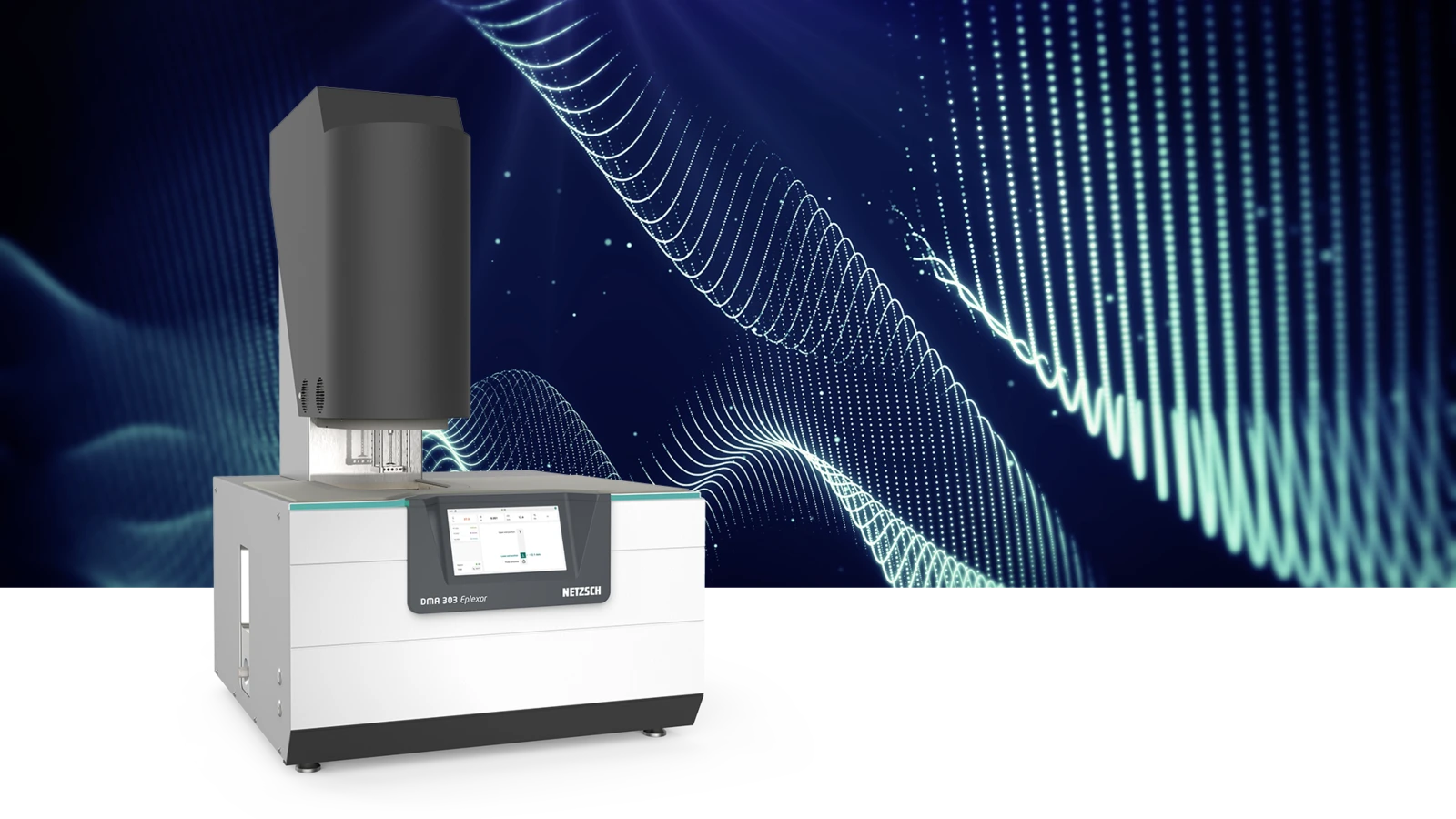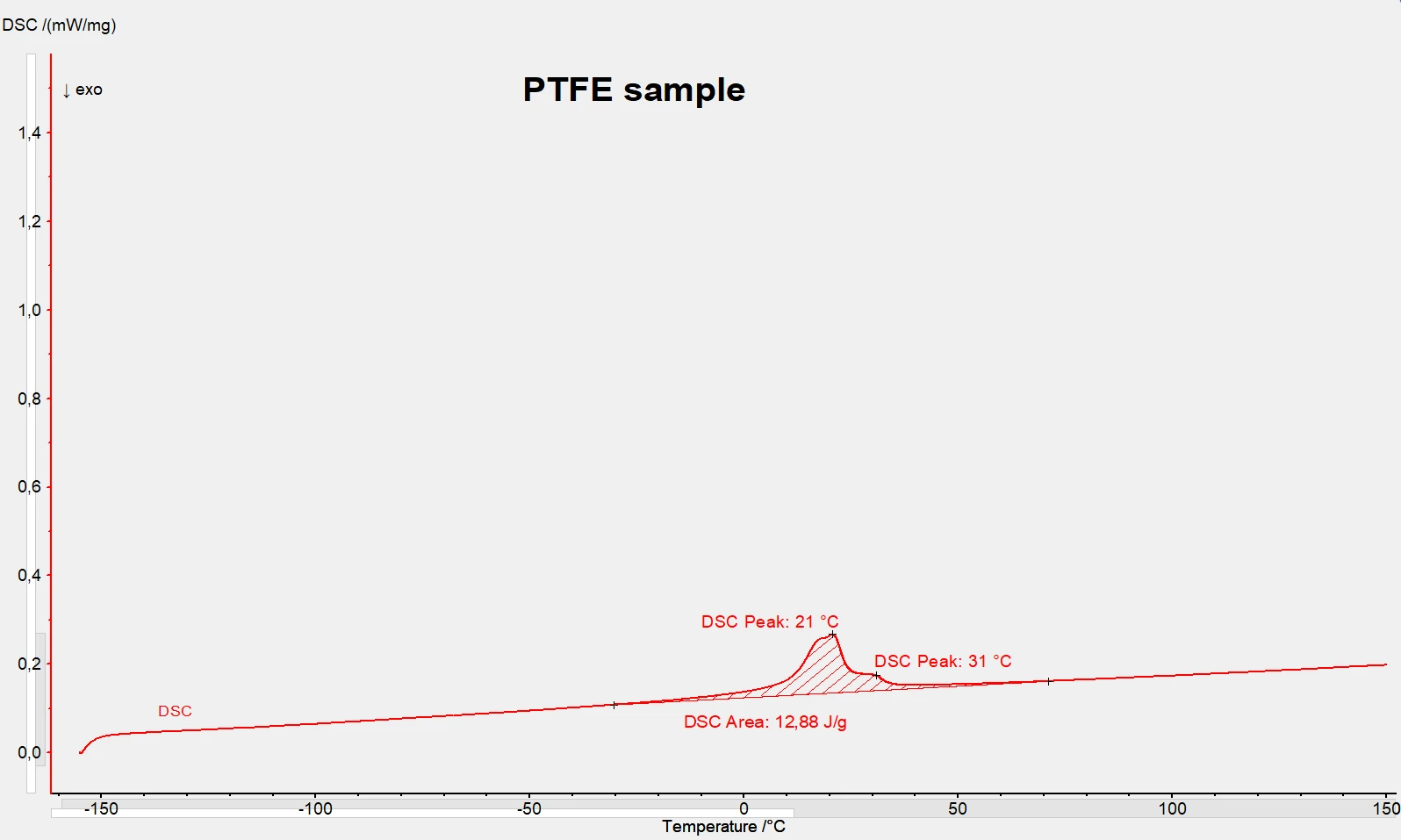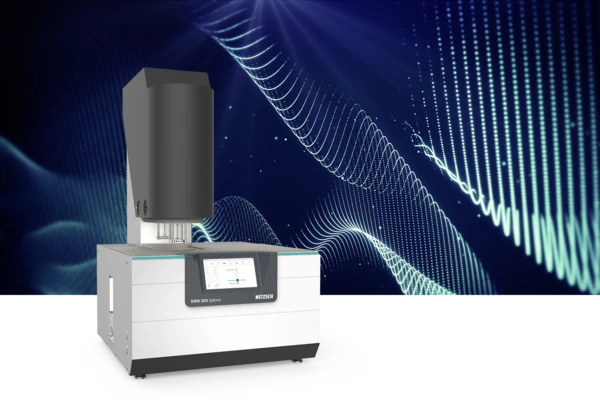
14.02.2024 by Rüdiger Sehling, Aileen Sammler
Why Is DMA That Important?
Comparing Measurement Results when Measuring Polytetrafluoroethylene (PTFE) by Means of Differential Scanning Calorimetry (DSC) and Dynamic-Mechanical Analysis (DMA)
When measuring polymer materials with a DSC (Differential Scanning Calorimeter), it can be difficult to monitor effects such as the Glass Transition TemperatureThe glass transition is one of the most important properties of amorphous and semi-crystalline materials, e.g., inorganic glasses, amorphous metals, polymers, pharmaceuticals and food ingredients, etc., and describes the temperature region where the mechanical properties of the materials change from hard and brittle to more soft, deformable or rubbery.glass transition. By means of DSC instruments, only the energetic effects of materials (endothermal/EgzotermicznyA sample transition or a reaction is exothermic if heat is generated.exothermal) are measured, i.e., the change in specific heat. With a DMA (Dynamic Mechanical Analyzer), however, it is not possible to detect energetic effects since the real mechanical material behavior is determined, and its change in mechanical properties (especially during the Glass Transition TemperatureThe glass transition is one of the most important properties of amorphous and semi-crystalline materials, e.g., inorganic glasses, amorphous metals, polymers, pharmaceuticals and food ingredients, etc., and describes the temperature region where the mechanical properties of the materials change from hard and brittle to more soft, deformable or rubbery.glass transition) is much more sensitive compared to energetic effects.
Figure 1 shows a typical DSC measurement on PTFE. Only two small endothermal effects can be seen from the change in crystalline structure. No more information can be gathered, although PTFE provides much more information.

Presented in figure 2 is a direct comparison of the DSC and DMA measurements on PTFE. The red curve shows the DSC results and the black curve the DMA results. The continuous black line represents the storage modulus, E’ (stiffness), and the black dashed curve the loss factor tand (damping). In the DMA measurement, it can clearly be seen that definitely more information is obtained compared to DSC. At the beginning in the low-temperature range a transition represented by the drop in storage modulus, E’, at -124°C (E’ onset) with a corresponding maximum in the loss factor, tand, at -104°C (tand peak) can be observed. This is the β-transition of PTFE. Another transition is found in the storage modulus, E’, at 19°C (E’ onset) which represents the solid/solid transition of PTFE that is also measurable by DSC. This transition is also associated with a peak maximum in the loss factor, tan d, at 29°C (tan d peak).

The Glass Transition TemperatureThe glass transition is one of the most important properties of amorphous and semi-crystalline materials, e.g., inorganic glasses, amorphous metals, polymers, pharmaceuticals and food ingredients, etc., and describes the temperature region where the mechanical properties of the materials change from hard and brittle to more soft, deformable or rubbery.glass transition of PTFE can be found at higher temperatures by the drop in storage modulus, E’, at 113°C with a corresponding peak maximum in the loss factor, tan d, at 128°C.
It can clearly be seen that DMA is a very sensitive method to detect Phase TransitionsThe term phase transition (or phase change) is most commonly used to describe transitions between the solid, liquid and gaseous states.phase transitions of materials, which are nearly impossible to detect by means of DSC.

Have you already heard of the new NETZSCH DMA 303 Eplexor®?
In this new single tabletop DMA, we combine highest force with widest temperature range.
Our latest development, the new NETZSCH DMA 303 Eplexor®, is designed for precise measurements on a broad variety of specimens including even very stiff samples with a controlled force range of up to 50 N, both statically and dynamically. The full resolution is available throughout the entire force range, resulting in accurate and reliable data.
The temperature-controlled furnace features an unprecedented broad temperature range of -170°C to 800°C, allowing for homogenous heat distribution around the sample. In addition, the force displacement range of ±30 mm is perfect for static experiments including creep and relaxation.
Gain Valuable Information with Dynamic-Mechanical Analysis
Dynamic Mechanical Analysis offers a wealth of information about your material:
- Viscoelastic material properties: storage (E’) and Viscous modulusThe complex modulus (viscous component), loss modulus, or G’’, is the “imaginary” part of the samples the overall complex modulus. This viscous component indicates the liquid like, or out of phase, response of the sample being measurement. loss modulus (E’’), loss factor (tan δ)
- Stiffness and damping properties under a variety of conditions:
- depending on temperature and frequency
- at different levels of StressStress is defined as a level of force applied on a sample with a well-defined cross section. (Stress = force/area). Samples having a circular or rectangular cross section can be compressed or stretched. Elastic materials like rubber can be stretched up to 5 to 10 times their original length.stress and StrainStrain describes a deformation of a material, which is loaded mechanically by an external force or stress. Rubber compounds show creep properties, if a static load is applied.strain
- under defined gas atmosphere and in liquid environments
- Identification of material reactions and Phase TransitionsThe term phase transition (or phase change) is most commonly used to describe transitions between the solid, liquid and gaseous states.phase transitions
- Glass transition temperature of highly cross-linked polymers and composites
- Compatibility of polymer blends in reference to composition and structure
- Influence of filler and additive contents
- Curing and post-curing of resins
- Analysis of aging influences
- Prediction of material behavior using Time-Temperature-Superposition (TTS)
- Creep and RelaxationWhen a constant strain is applied to a rubber compound, the force necessary to maintain that strain is not constant but decreases with time; this behavior is known as stress relaxation. The process responsible for stress relaxation can be physical or chemical, and under normal conditions, both will occur at the same time. relaxation processes





